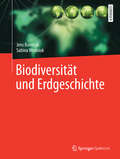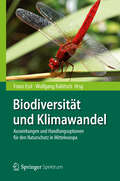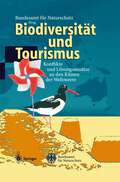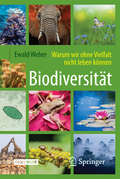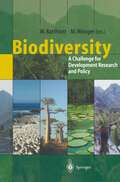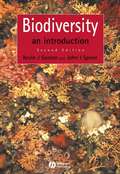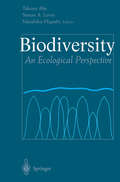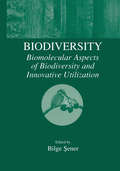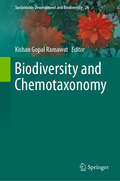- Table View
- List View
Biodiesel Fuels: Science, Technology, Health, and Environment (Handbook of Biodiesel and Petrodiesel Fuels)
by Ozcan KonurThis first volume of the Handbook of Biodiesel and Petrodiesel Fuels presents a representative sample of the population papers in the field of biodiesel fuels in general. Part I provides an overview of the research field on both biodiesel and petrodiesel fuels highlighting primary and secondary research fronts in these fields. Part II presents a representative sample of the population papers in the field of biooils covering major research fronts. The research on the biooils is a fundamental part of the research on the biodiesel fuels. The research in this field has intensified in recent years with the application of advanced catalytic technologies and nanotechnologies in both production and upgrading of biooils. It covers pyrolysis, hydrothermal liquefaction, and upgrading, and characterization and properties of biooils besides an overview of the research field. Part III presents a representative sample of the population papers in the field of biodiesel fuels in general covering major research fronts. The research in this field has progressed in the lines of production, properties, and emissions of biodiesel fuels. As in the case of biooils, catalysts and additives play a crucial role for the biodiesel fuels. It covers biomass-based catalyst-assisted biodiesel production, enzymatic biodiesel production, additives in biodiesel production, properties, characterization, performance, and policies of biodiesel fuels besides an overview of the research field. Part IV presents a representative sample of the population papers in the field of glycerol, biodiesel waste, covering major research fronts. The research in this field has intensified in recent years with the increasing volume of biodiesel fuels, creating eco-friendly solutions for these wastes of biodiesel fuels for producing valuable biofuels and biochemicals from glycerol. It covers biohydrogen and propanediol production from glycerol as a case study for bioenergy and biochemicals, respectively. This book will be useful to academics and professionals in the fields of Energy Fuels, Chemical Engineering, Physical Chemistry, Biotechnology and Applied Microbiology, Environmental Sciences, and Thermodynamics. Ozcan Konur is both a materials scientist and social scientist by training. He has published around 200 journal papers, book chapters, and conference papers. He has focused on the bioenergy and biofuels in recent years. In 2018, he edited Bioenergy and Biofuels, which brought together the work of over 30 experts in their respective field. He also edited the Handbook of Algal Science, Technology, and Medicine with a strong section on the algal biofuels in 2020.
Biodiesel Fuels: Science, Technology, Health, and Environment (Handbook of Biodiesel and Petrodiesel Fuels)
by Ozcan KonurThis first volume of the Handbook of Biodiesel and Petrodiesel Fuels presents a representative sample of the population papers in the field of biodiesel fuels in general. Part I provides an overview of the research field on both biodiesel and petrodiesel fuels highlighting primary and secondary research fronts in these fields. Part II presents a representative sample of the population papers in the field of biooils covering major research fronts. The research on the biooils is a fundamental part of the research on the biodiesel fuels. The research in this field has intensified in recent years with the application of advanced catalytic technologies and nanotechnologies in both production and upgrading of biooils. It covers pyrolysis, hydrothermal liquefaction, and upgrading, and characterization and properties of biooils besides an overview of the research field. Part III presents a representative sample of the population papers in the field of biodiesel fuels in general covering major research fronts. The research in this field has progressed in the lines of production, properties, and emissions of biodiesel fuels. As in the case of biooils, catalysts and additives play a crucial role for the biodiesel fuels. It covers biomass-based catalyst-assisted biodiesel production, enzymatic biodiesel production, additives in biodiesel production, properties, characterization, performance, and policies of biodiesel fuels besides an overview of the research field. Part IV presents a representative sample of the population papers in the field of glycerol, biodiesel waste, covering major research fronts. The research in this field has intensified in recent years with the increasing volume of biodiesel fuels, creating eco-friendly solutions for these wastes of biodiesel fuels for producing valuable biofuels and biochemicals from glycerol. It covers biohydrogen and propanediol production from glycerol as a case study for bioenergy and biochemicals, respectively. This book will be useful to academics and professionals in the fields of Energy Fuels, Chemical Engineering, Physical Chemistry, Biotechnology and Applied Microbiology, Environmental Sciences, and Thermodynamics. Ozcan Konur is both a materials scientist and social scientist by training. He has published around 200 journal papers, book chapters, and conference papers. He has focused on the bioenergy and biofuels in recent years. In 2018, he edited Bioenergy and Biofuels, which brought together the work of over 30 experts in their respective field. He also edited the Handbook of Algal Science, Technology, and Medicine with a strong section on the algal biofuels in 2020.
Biodiesel Fuels Based on Edible and Nonedible Feedstocks, Wastes, and Algae: Science, Technology, Health, and Environment (Handbook of Biodiesel and Petrodiesel Fuels)
by Ozcan KonurThis second volume of the Handbook of Biodiesel and Petrodiesel Fuels presents a representative sample of the population papers in the field of feedstock-specific biodiesel fuels. The research on feedstocks for biodiesel fuels has first focused on the edible oils as first-generation biodiesel fuels. However, the public concerns about the competition with foods based on these feedstocks and adverse impact on the ecological diversity and deforestation have resulted in the exploration of nonedible-oil-based biodiesel fuels as second-generation biodiesel fuels in the first instance. Due to the ecological and cost benefits of treating wastes, waste oil-based biodiesel fuels as third-generation biodiesel fuels have emerged. Furthermore, following a series of influential review papers, the research has focused on the algal oil-based biodiesel fuels in recent years. Since the cost of feedstocks in general constitutes 85% of the total biodiesel production costs, the research focused more on improving biomass and lipid productivity in these research fields. Furthermore, since water, CO2, and nutrients (primarily N and P) have been major ingredients for the algal biomass and lipid production, the research has also intensified in the use of wastewaters and flue gases for algal biomass production to reduce the ecological burdens and the production costs. Part 1 presents a representative sample of the population papers in the field of edible oil-based biodiesel fuels covering major research fronts. It covers soybean oil-based biodiesel fuels, palm oil-based biodiesel fuels, and rapeseed oil-based biodiesel fuels as case studies besides an overview paper. Part 2 presents a representative sample of the population papers in the field of nonedible oil-based biodiesel fuels covering major research fronts. It covers Jatropha oil-based biodiesel fuels, polanga oil-based biodiesel fuels, and moringa oil-based biodiesel fuels as case studies besides an overview paper. Part 3 presents a representative sample of the population papers in the field of waste oil-based biodiesel fuels covering major research fronts. It covers wastewater sludge-based biodiesel fuels, waste cooking oil-based biodiesel fuels, and microbial oil-based biodiesel fuels as case studies besides an overview paper. Part 4 presents a representative sample of the population papers in the field of algal oil-based biodiesel fuels covering major research fronts. It covers algal biomass production in general, algal biomass production in wastewaters, algal lipid production, hydrothermal liquefaction of algal biomass, algal lipid extraction, and algal biodiesel production besides an overview paper. This book will be useful to academics and professionals in the fields of Energy Fuels, Chemical Engineering, Physical Chemistry, Biotechnology and Applied Microbiology, Environmental Sciences, and Thermodynamics. Ozcan Konur is both a materials scientist and social scientist by training. He has published around 200 journal papers, book chapters, and conference papers. He has focused on the bioenergy and biofuels in recent years. In 2018, he edited ‘Bioenergy and Biofuels’, that brought together the work of over 30 experts in their respective field. He also edited ‘Handbook of Algal Science, Technology, and Medicine’ with a strong section on the algal biofuels in 2020.
Biodiesel Fuels Based on Edible and Nonedible Feedstocks, Wastes, and Algae: Science, Technology, Health, and Environment (Handbook of Biodiesel and Petrodiesel Fuels)
by Ozcan KonurThis second volume of the Handbook of Biodiesel and Petrodiesel Fuels presents a representative sample of the population papers in the field of feedstock-specific biodiesel fuels. The research on feedstocks for biodiesel fuels has first focused on the edible oils as first-generation biodiesel fuels. However, the public concerns about the competition with foods based on these feedstocks and adverse impact on the ecological diversity and deforestation have resulted in the exploration of nonedible-oil-based biodiesel fuels as second-generation biodiesel fuels in the first instance. Due to the ecological and cost benefits of treating wastes, waste oil-based biodiesel fuels as third-generation biodiesel fuels have emerged. Furthermore, following a series of influential review papers, the research has focused on the algal oil-based biodiesel fuels in recent years. Since the cost of feedstocks in general constitutes 85% of the total biodiesel production costs, the research focused more on improving biomass and lipid productivity in these research fields. Furthermore, since water, CO2, and nutrients (primarily N and P) have been major ingredients for the algal biomass and lipid production, the research has also intensified in the use of wastewaters and flue gases for algal biomass production to reduce the ecological burdens and the production costs. Part 1 presents a representative sample of the population papers in the field of edible oil-based biodiesel fuels covering major research fronts. It covers soybean oil-based biodiesel fuels, palm oil-based biodiesel fuels, and rapeseed oil-based biodiesel fuels as case studies besides an overview paper. Part 2 presents a representative sample of the population papers in the field of nonedible oil-based biodiesel fuels covering major research fronts. It covers Jatropha oil-based biodiesel fuels, polanga oil-based biodiesel fuels, and moringa oil-based biodiesel fuels as case studies besides an overview paper. Part 3 presents a representative sample of the population papers in the field of waste oil-based biodiesel fuels covering major research fronts. It covers wastewater sludge-based biodiesel fuels, waste cooking oil-based biodiesel fuels, and microbial oil-based biodiesel fuels as case studies besides an overview paper. Part 4 presents a representative sample of the population papers in the field of algal oil-based biodiesel fuels covering major research fronts. It covers algal biomass production in general, algal biomass production in wastewaters, algal lipid production, hydrothermal liquefaction of algal biomass, algal lipid extraction, and algal biodiesel production besides an overview paper. This book will be useful to academics and professionals in the fields of Energy Fuels, Chemical Engineering, Physical Chemistry, Biotechnology and Applied Microbiology, Environmental Sciences, and Thermodynamics. Ozcan Konur is both a materials scientist and social scientist by training. He has published around 200 journal papers, book chapters, and conference papers. He has focused on the bioenergy and biofuels in recent years. In 2018, he edited ‘Bioenergy and Biofuels’, that brought together the work of over 30 experts in their respective field. He also edited ‘Handbook of Algal Science, Technology, and Medicine’ with a strong section on the algal biofuels in 2020.
Biodiesel Production with Green Technologies
by Aminul Islam Pogaku RavindraThis book provides a single-source reference to green technologies in advanced biofuel technology. The main focus is on the description of the state of the art in catalytic processes for the "green" production of biofuels. The authors describe two different, practical approaches for catalysts, which allow for effective and easy separation of the catalyst by simple filtration, and enable reuse for several cycles. Readers will gain understanding as to the mechanisms involved in the synthesis and structure formation of the catalyst, in order to maximize yield of biodiesel production. The authors also address the question of how catalytic material should be distributed inside a porous support to obtain optimal performance. The effects of physicochemical and operating parameters are analyzed to gain insight into the underlying phenomena governing the performance of optimally designed catalysts.
Biodiesel Technology and Applications
by Inamuddin Mohd Imran Ahamed Rajender Boddula Mashallah RezakazemiEnergy technologies have attracted great attention due to the fast development of sustainable energy. Biodiesel technologies have been identified as the sustainable route through which overdependence on fossil fuels can be reduced. Biodiesel has played a key role in handling the growing challenge of a global climate change policy. Biodiesel is defined as the monoalkyl esters of vegetable oils or animal fats. Biodiesel is a cost-effective, renewable, and sustainable fuel that can be made from vegetable oils and animal fats. Compared to petroleum-based diesel, biodiesel would offer a non-toxicity, biodegradability, improved air quality and positive impact on the environment, energy security, safe-to-handle, store and transport and so on. Biodiesels have been used as a replacement of petroleum diesel in transport vehicles, heavy-duty trucks, locomotives, heat oils, hydrogen production, electricity generators, agriculture, mining, construction, and forestry equipment. This book describes a comprehensive overview, covering a broad range of topics on biodiesel technologies and allied applications. Chapters cover history, properties, resources, fabrication methods, parameters, formulations, reactors, catalysis, transformations, analysis, in situ spectroscopies, key issues and applications of biodiesel technology. It also includes biodiesel methods, extraction strategies, biowaste utilization, oleochemical resources, non-edible feedstocks, heterogeneous catalysts, patents, and case-studies. Progress, challenges, future directions, and state-of-the-art biodiesel commercial technologies are discussed in detail. This book is an invaluable resource guide for professionals, faculty, students, chemical engineers, biotechnologists, and environmentalists in these research and development areas.
Biodiesel Technology and Applications
by Inamuddin Mohd Imran Ahamed Rajender Boddula Mashallah RezakazemiEnergy technologies have attracted great attention due to the fast development of sustainable energy. Biodiesel technologies have been identified as the sustainable route through which overdependence on fossil fuels can be reduced. Biodiesel has played a key role in handling the growing challenge of a global climate change policy. Biodiesel is defined as the monoalkyl esters of vegetable oils or animal fats. Biodiesel is a cost-effective, renewable, and sustainable fuel that can be made from vegetable oils and animal fats. Compared to petroleum-based diesel, biodiesel would offer a non-toxicity, biodegradability, improved air quality and positive impact on the environment, energy security, safe-to-handle, store and transport and so on. Biodiesels have been used as a replacement of petroleum diesel in transport vehicles, heavy-duty trucks, locomotives, heat oils, hydrogen production, electricity generators, agriculture, mining, construction, and forestry equipment. This book describes a comprehensive overview, covering a broad range of topics on biodiesel technologies and allied applications. Chapters cover history, properties, resources, fabrication methods, parameters, formulations, reactors, catalysis, transformations, analysis, in situ spectroscopies, key issues and applications of biodiesel technology. It also includes biodiesel methods, extraction strategies, biowaste utilization, oleochemical resources, non-edible feedstocks, heterogeneous catalysts, patents, and case-studies. Progress, challenges, future directions, and state-of-the-art biodiesel commercial technologies are discussed in detail. This book is an invaluable resource guide for professionals, faculty, students, chemical engineers, biotechnologists, and environmentalists in these research and development areas.
Biodiversität: Grundlagen, Gefährdung, Schutz
by Rüdiger Wittig Manfred NiekischDer Botaniker Rüdiger Wittig und der Zoologe Manfred Niekisch geben einen breiten Überblick über die Diversität des Lebens auf der Erde. Sie zeigen nicht nur allgemein verständlich die wissenschaftlichen Grundlagen auf, sondern gehen ausführlich ein auf die materielle und spirituelle Bedeutung der Biodiversität für den Menschen und insbesondere auf die Umweltdienstleistungen, welche Ökosysteme erbringen. Ebenso dargestellt werden die Gründe der Gefährdung der Biodiversität sowie die Konventionen, rechtlichen Instrumente und praktischen Möglichkeiten, welche für den Schutz von Tieren, Pflanzen und Ökosystemen zur Verfügung stehen. Beleuchtet wird auch die Rolle der Nichtregierungsorganisationen.
Biodiversität, Ökosystemfunktionen und Naturschutz
by Werner HärdtleDer weltweite Verlust an biologischer Vielfalt, verursacht durch eine nicht nachhaltige Nutzung von Ökosystemen, birgt schwerwiegende gesamtgesellschaftliche Risiken, welche jenen des Klimawandels vergleichbar sind. Doch erst seit wenigen Jahren verstehen wir genauer, warum biologische Vielfalt eine Grundvoraussetzung für die Stabilität und das Funktionieren von Ökosystemen und damit auch für gesellschaftlichen Wohlstand ist. Das vorliegende Buch stellt in anschaulicher und allgemeinverständlicher Form das heute verfügbare Wissen über die „funktionelle Bedeutung“ der globalen biologischen Vielfalt vor und erläutert anhand von faszinierenden und vielen wissenschaftlich neuen Beispielen, warum wir den Schutz der biologischen Vielfalt als dringende, gesamtgesellschaftliche Aufgabe begreifen müssen. Es erklärt, wie Pflanzen- und Tierarten miteinander zusammenleben und wie gerade ihre Wechselbeziehungen verschiedenste Ökosysteme – einem Uhrwerk vergleichbar – zum „funktionieren“ bringen oder diese gar gegenüber Störungen oder globalen Veränderungen stabilisieren. Anhand gut verständlicher und fesselnder Fallbeispiele zeigt das Buch, wie Artenvielfalt und diverse Lebensgemeinschaften unabdingbar sind für intakte Ökosysteme, und dass wir eine ungestörte Artenvielfalt schon deshalb benötigen, weil ohne sie die von uns Menschen zum Überleben notwendigen Serviceleistungen der Ökosysteme gar nicht zustande kämen.
Biodiversität und Erdgeschichte
by Jens Boenigk Sabina WodniokDieses inspirierende und motivierende Lehrbuch zeichnet fächerübergreifend ein beeindruckendes Gesamtbild der biologischen Vielfalt. Spannende Aspekte der Evolution der Erde und des Lebens werden durch interdisziplinäre Verknüpfung geowissenschaftlicher und biowissenschaftlicher Aspekte aus einer ganz neuen Perspektive anschaulich vermittelt. Der Schwerpunkt liegt hierbei – unter Einbeziehung aktuellster wissenschaftlicher Erkenntnisse – auf dem Verständnis von Konzepten und Mechanismen.Dieses Buch richtet sich an Studierende der Bio- und Geowissenschaften und an alle an der Vielfalt des Lebens interessierten Leser. Das innovative Lehrbuchkonzept regt – gleichzeitig als Lesebuch, Bilderbuch und Lexikon der organismischen Biologie – sowohl Anfänger als auch Fortgeschrittene zu einem visuellen und intuitiven Lernen an. Jede Doppelseite bietet ein in sich geschlossenes, anschaulich bebildertes Kapitel mit themenbezogenem Glossar und weiterführenden Verweisen. Für Dozenten und Lehrer, für Schule und Hochschule bietet dieses Buch ein reichhaltiges Nachschlagewerk und einen umfassenden Fundus an didaktisch durchdachten und lernfreundlich illustrierten Lehrmaterialien.Der Inhalt reicht von der Entstehung der Erde über die geowissenschaftlichen Rahmenbedingungen und die Verknüpfung zwischen biologischer und geologischer Evolution bis zur Entstehung des Menschenvon grundlegenden Mechanismen der Entstehung und Erhaltung der Diversität bis zur globalen Verteilung der heutigen Biodiversitätvon den Anfängen der biologischen Systematik in der griechischen Philosophie und der Bibel über die darwinsche Evolution und die Struktur und Funktion von Arten und Organismen bis zu den modernen Erkenntnissen der Megasystematik und Phylogenie.Mit diesem einzigartigen Konzept verschafft dieses Lehrbuch einen soliden Überblick über die Erdgeschichte und Biodiversität. Die Verknüpfung der verschiedenen Fachdisziplinen fördert das Verständnis übergeordneter Prinzipien und naturwissenschaftlicher Zusammenhänge.
Biodiversität und Klimawandel: Auswirkungen und Handlungsoptionen für den Naturschutz in Mitteleuropa
by Stefan RahmstorfDas Buch bietet einen zusammenfassenden Überblick über die Effekte des Klimawandels auf die Biodiversität in Mitteleuropa. Im Mittelpunkt steht die Bewertung der beobachteten und prognostizierten Folgen für Arten und Lebensräume sowie die Ableitung von Handlungsoptionen. Die Autoren berücksichtigen die Zusammenhänge mit der Land- und Forstwirtschaft, Jagd und Fischerei sowie Implikationen für die Gesundheitsvorsorge. Auch die Wechselwirkungen mit globalen Entwicklungen wie biologische Invasionen oder der Landnutzungswandel werden diskutiert.
Biodiversität und Tourismus: Konflikte und Lösungsansätze an den Küsten der Weltmeere
by I. DahmsDie "Konvention über die biologische Vielfalt", ein Ergebnis der Konferenz der Vereinten Nationen für Umwelt und Entwicklung (UNCED) 1992 in Rio de Janeiro, hat die verschiedenen internationalen Naturschutzbemühungen erstmals auf eine umfassende, globale Grundlage gestellt. Die unterzeichnenden Staaten verpflichten sich die biologische Vielfalt der Erde zu schützen und gleichzeitig nachhaltig zu nutzen. Eine der Nutzungen, die Auswirkungen auf die globale Biodiversität haben, ist der Tourismus. Hier werden am Beispiel vorwiegend europäischer Küstenregionen, den Hauptzentren des Tourismus, Konflikte zwischen Naturschutz und touristischer Nutzung erläutert und Lösungsansätze zur Minimierung von Konflikten vorgestellt.
Biodiversität - Warum wir ohne Vielfalt nicht leben können
by Ewald WeberEine Einladung in die Biologie der Vielfalt Dieses Buch berichtet über ein ebenso spannendes wie aktuelles Thema an der Schnittstelle zwischen naturwissenschaftlicher Grundlagenforschung und globaler gesellschaftlicher Herausforderung: die Biodiversität. Drei Ebenen kommen hier zusammen: die Vielfalt der Arten in einem Lebensraum, die Vielfalt der Ökosysteme und Lebensräume selbst und die Vielfalt der Gene in den Lebewesen. Der Autor, Biologe und selbst in der Biodiversitätsforschung tätig, nimmt Sie mit auf eine aufregende Entdeckungsreise durch diese mannigfach vernetzte Welt. In leicht verständlicher Sprache und mit vielen anschaulichen Beispielen erklärt er Zusammenhänge und Hintergründe. Wie ist Biodiversität eigentlich definiert, und mit welchen Techniken wird sie erfasst? Wie ist die immense Artenvielfalt auf der Erde entstanden, und wie entwickelt sie sich weiter? Welchen Nutzen hat die Biodiversität auf den verschiedenen Ebenen? In welchem Maße ist die Vielfalt der Arten und Lebensräume heute bedroht, und wie kann man diesem Trend entgegenwirken? Solche und ähnliche Fragen beantwortet dieses Buch, in dessen breitem Themenbogen sich die Vielfalt seines Gegenstands wiederspiegelt. Tauchen Sie ein in die faszinierende Welt der Biodiversität! Der AutorEwald Weber ist Biologe und Sachbuchautor. Er lehrt und forscht an der Universität Potsdam mit Schwerpunkt Biodiversität. Sein Anliegen als Autor ist das Vermitteln von wissenschaftlichen Zusammenhängen und von Naturgeschichte im weitesten Sinn.
Biodiversity: A Challenge for Development Research and Policy
by N. BiedingerBiodiversity, sometimes simply understood as "diversity of species", is a specific quality of life on our planet, the dimensions and importance of which have just lately been fully realized. Today we know that "biological diversity is a global asset of incalculable value to present and future generations" (Kofi Annan). Biodiversity is spread unequally over the world: in fact, the main share of biological resources worldwide is harboured predominantly by the so-called developing countries in the tropics and sub tropics. Therefore, Biodiversity - A Challenge for Development Research and Policy was chosen as the title for an international conference which was held in Bonn in 1997 as one of the first major events organized by the then newly established North-South Centre for Development Research (ZEF) at Rheinische Friedrich-Wilhelms-Universitat Bonn (Germany). Since the ZEF, founded by the Senate of the University of Bonn in 1995, has played a central role in turning Bonn into a centre for international cooperation and North-South dialogue. The Centre is a product of the Bonn Berlin agreement of July 1994 which was adopted to offset the effects caused by the Parliament and much of the Government moving to Berlin. It fits in well with the double strategy to strengthen Bonn's position as an interna tional science arena and as an eminent place for development policy and the national and supranational agencies dealing with this issue.
Biodiversity: An Introduction
by Kevin J. Gaston John I. SpicerCLICK HERE TO DOWNLOAD ARTWORK This concise introductory text provides a complete overview of biodiversity - what it is, how it arose, its distribution, why it is important, human impact upon it, and what should be done to maintain it. Timely overview of the serious attempts made to quantify and describe biodiversity in a scientific way Acts as an easy entry point into the primary literature Provides real-world examples of key issues, including illustrations of major temporal and spatial patterns in biodiversity Designed primarily with undergraduate students and course lecturers in mind, it will also be of interest to anyone who requires an overview of, and entry to, the vast literature on these topics. All the figures included in the book are downloadable from the Blackwell Publishing website
Biodiversity: An Introduction
by Kevin J. Gaston John I. SpicerCLICK HERE TO DOWNLOAD ARTWORK This concise introductory text provides a complete overview of biodiversity - what it is, how it arose, its distribution, why it is important, human impact upon it, and what should be done to maintain it. Timely overview of the serious attempts made to quantify and describe biodiversity in a scientific way Acts as an easy entry point into the primary literature Provides real-world examples of key issues, including illustrations of major temporal and spatial patterns in biodiversity Designed primarily with undergraduate students and course lecturers in mind, it will also be of interest to anyone who requires an overview of, and entry to, the vast literature on these topics. All the figures included in the book are downloadable from the Blackwell Publishing website
Biodiversity: Maintenance, Function, Origin, and Self-Organisation into Life-Support Systems
by Edmundas LekevičiusSpecies are not functionally independent. From a long-term perspective, only ecosystem with a fully integrated nutrient cycle is alive. The lack of trophic autonomy should be considered one of the key factors that ensure and maintain biodiversity. The variability of abiotic conditions, both in space and in time, also creates a huge diversity of niches and subniches for genotypes and species. In addition, life maintains its essential variables (biomass and productivity) as stable as possible due to the diversity of structures (genes, macromolecules, metabolic pathways, genotypes, species, etc.): the structures that reach optima are multiplied and thus activated, while the functioning of those which lost their optima is suppressed. The facts and concepts presented in this monograph thus support the conclusions that (a) genotype and species diversity is supported by trophic specialisation (b) biodiversity helps to stabilise the functions (essential variables) of individuals, populations, and ecological communities (c) in evolution, the emergence of biodiversity is determined by heritable variation and the advantage of specialised (more effective) structures over non-specialised ones (d) biodiversity is characterised by its ability to increase itself and to organise itself into relatively consistent structures, which we call production pyramids and nutrient cycles. This book therefore provides an answer to the question "why the diversity of life is of such and such a nature".
Biodiversity
by Christian Lévêque Jean-Claude MounolouThe title provides an overview of the current knowledge about the diversity of the living world and the various problems associated with its conservation and sustainable use. Covering both the fundamentals of the subject, along with the latest research, Biodiversity presents key conservation issues within a framework of global case studies. Starting with a summary of the concept of biodiversity, the text then explores such subjects as species richness, ecological systems, the consequences of human activities, diversity and human health, genetic resources, biotechnology and conservation. Comprehensive introduction to key issues surrounding the study of biodiversity. Extensive bibliography and references to numerous relevant websites. Introduces current research in the field within a framework of useful case studies.
Biodiversity: An Ecological Perspective
by MasahikoHigashi Simon A. Levin TakuyaAbeDespite acknowledgment that loss of living diversity is an international biological crisis, the ecological causes and consequences of extinction have not yet been widely addressed. In honor of Edward O. Wilson, winner of the 1993 International Prize for Biology, an international group of distinguished biologists bring ecological, evolutionary, and management perspectives to the issue of biodiversity. The roles of ecosystem processes, community structure and population dynamics are considered in this book. The goal, as Wilson writes in his introduction, is "to assemble concepts that unite the disciplines of systematics and ecology, and in so doing to create a sound scientific basis for the future management of biodiversity."
Biodiversity: Exploring Values and Priorities in Conservation
by D. J. Perlman G. AdelsonBiodiversity has become a buzzword in the environmental movement and in science, and is increasingly being taught in university degree courses. This new text is designed as a primer, giving non-specialists an introduction to the historical context, current debates, and ongoing research in this subject.
Biodiversity: Biomolecular Aspects of Biodiversity and Innovative Utilization
by Bilge SenerProceedings of the 3rd IUPAC International Conference on Biodiversity (ICOB-3), November 3-8, 2001, Antalya, Turkey. This book discusses the value of bioresources and the need for their conservation in terms of the biomolecular chemistry of naturally occurring molecular systems. The development of pharmaceutical, agricultural and industrial products from bioresources can be used to promote incentives for conservation by providing an economic return to sustainable use of those sources. The 54 chapters inform readers on the search for insight into the species and documents how much of life remains to be scientifically identified. They also explore identification strategies and methods along with the implications for protecting biodiversity. In summary, biomolecular aspects of biodiversity and innovative utilization of bioresources are discussed from very diverse points of view ranging from their botanical, zoological, taxonomic and genomic expressions to their biomolecular, structural, mechanistic and functional aspects.
Biodiversity: Threats and Conservation (Translating Animal Science Research)
by R. C. SobtiThe term "biodiversity" or "biological diversity" describes the variety of living beings on Earth encompassing microorganisms, plants, animals, and ecosystems, such as coral reefs, forests, and deserts. In fact, it also represents a wealth of biological resources available to us. Today, instead of exploring and preserving its unmapped biodiversity, mankind has gone away from mother nature, conquering the domain through relentless exploitation. This has resulted in an ecological imbalance and thereby has posed serious threat to biodiversity. Declining biodiversity is, therefore, a concern for countless reasons. Biodiversity’s wealth of genetic information can be conserved by storing biological material from endangered species. Cell lines, gametes, and embryos are preserved so that in case a species becomes extinct or there is a need to increase the population of the species, then cloning and artificial reproductive techniques can be used to revive and reproduce the said species. The present volume discusses the biodiversity of specific animal groups, such as cnidarians and fish, as well as potential risks to and methods for conserving some of them. The following important aspects are addressed: 1. The importance of biodiversity in maintaining ecosystem balance for sustainability 2. The emerging role of biodiversity as a source of important materials, pharmaceuticals, food, and so on as such or through genetic manipulation to meet the contemporary and future challenges 3. The impact of environment degradation on biodiversity and conservation in a changing environment 4. Conventional and emerging biotechnological techniques to conserve biodiversity The book is intended for academics, scientists, and naturalists working in the fields of biology, biochemistry, biophysics, and biomedical sciences.
Biodiversity: Threats and Conservation (Translating Animal Science Research)
by Rc SobtiThe term "biodiversity" or "biological diversity" describes the variety of living beings on Earth encompassing microorganisms, plants, animals, and ecosystems, such as coral reefs, forests, and deserts. In fact, it also represents a wealth of biological resources available to us. Today, instead of exploring and preserving its unmapped biodiversity, mankind has gone away from mother nature, conquering the domain through relentless exploitation. This has resulted in an ecological imbalance and thereby has posed serious threat to biodiversity. Declining biodiversity is, therefore, a concern for countless reasons. Biodiversity’s wealth of genetic information can be conserved by storing biological material from endangered species. Cell lines, gametes, and embryos are preserved so that in case a species becomes extinct or there is a need to increase the population of the species, then cloning and artificial reproductive techniques can be used to revive and reproduce the said species. The present volume discusses the biodiversity of specific animal groups, such as cnidarians and fish, as well as potential risks to and methods for conserving some of them. The following important aspects are addressed: 1. The importance of biodiversity in maintaining ecosystem balance for sustainability 2. The emerging role of biodiversity as a source of important materials, pharmaceuticals, food, and so on as such or through genetic manipulation to meet the contemporary and future challenges 3. The impact of environment degradation on biodiversity and conservation in a changing environment 4. Conventional and emerging biotechnological techniques to conserve biodiversity The book is intended for academics, scientists, and naturalists working in the fields of biology, biochemistry, biophysics, and biomedical sciences.
Biodiversity 101 (Science 101)
by Melina Laverty Eleanor Sterling Amelia Chiles Georgina CullmanWhat should the average person know about science? Because science is so central to life in the 21st century, science educators and other leaders of the scientific community believe that it is essential that everyone understand the basic concepts of the most vital and far-reaching disciplines. Biodiversity 101 does exactly that. This accessible volume provides readers—whether students new to the field or just interested members of the lay public—with the essential ideas of the origins of humans using a minimum of jargon and mathematics. Concepts are introduced in a progressive order so that more complicated ideas build on simpler ones, and each is discussed in small, bite-sized segments so that they can be more easily understood.
Biodiversity and Chemotaxonomy (Sustainable Development and Biodiversity #24)
by Kishan Gopal RamawatPlant classifications are based on morphological characters and it is difficult, particularly in small plants and grasses, to identify these below generic level on the basis of these characters using a dissecting microscope. Plant species have intra- and inter-specific variation in secondary metabolites which can be utilized as marker compounds for identification and classification of plants. Secondary metabolites are produced as a result of primary metabolism and the production of these compounds not only involves several genes but also it is an energy dependent process. Hence these products cannot be considered as insignificant for the plant and the environment. Modern tools of molecular biology and secondary metabolites present in them can definitively decide about classification of plants. Absence of correct identification of plant is associated to many problems of resource utilization. Due to wide availability of these tools, interest has revived in systematics and correct classification of plants based on these parameters for their sustainable utilization and resource management. The purpose of this book is to assess the potential of phytochemical and molecular tools in the systematic and classification of plants. The topics covered include species concept, barcoding and phylogenetic analysis, chemotaxonomy use of polyketides, carotenes, cuticular wax, volatile oils, biodiversity of corals, metazoans, Ruta and Echinocereus. It provides comprehensive and broad subject-based reviews, useful for students, teachers, researchers, and all others interested in the field. The field has been kept wide and general to accommodate the wide-ranging topics. This book will be useful to agriculturists, chemists, botanists, industrialists, and those involved in planning of crop plants.






